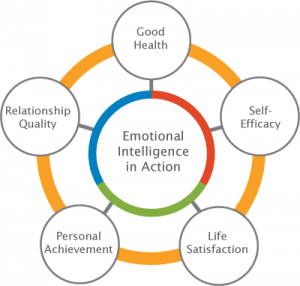What Is
Social Emotional
Learning?
Why is SEL so
important?
What are the skills children need to navigate the complexity of their lives… now and for the future? While many traditional academic skills are essential, there are key social emotional skills they also need.
What if every child were supported to develop these skills… with the role-modeling of every educator and parent also growing these essential social and emotional skills? Not only would kids’ lives improve, but a growing body of research shows that these learnable, measurable skills are essential to academic achievement, AND are essential for success and wellbeing of educators and parents.
Why Social Emotional Learning?
The learnable, measurable skills of emotional intelligence are correlated with increased academic achievement, better health, stronger relationships, greater self-efficacy, and improved quality of life. Read Six Seconds’ Case for EQ in Schools 2016 for up-to-date research and best practices. For adults, these skills are also invaluable (here’s evidence), which is one reason the World Economic Forum has identified EQ as one of the critical skills for the future workforce.
What is Social Emotional Learning?
Social and emotional learning (SEL) is the process through which children and adults grow and practice emotional intelligence. Effective SEL is not a “program,” or a “curriculum,” rather, it’s a foundation for a great place to learn. The benefits of SEL come from adults and children actively practicing EQ (being smarter with feelings) to cocreate a context for optimal learning – including equity and belonging for every child and adult.
How is Social Emotional Learning implemented?
As shown in the Benchmarks for Social Emotional Learning, a comprehensive SEL approach includes the development of social emotional skills for everyone in the school community. At Six Seconds, we believe that a foundational requirement is for educators to go first in actively learning and practicing these skills — and then supporting children, parents, and others to as well.
The graphic of 3 rings shows that students are part of a larger system. A systems-level approach to SEL considers the three strands explained in the Benchmarks:
Everyone develops and practices EQ skills (eg students, teachers, parents, administrators, staff, community members)
SEL is used to enhance classroom learning
The school community as a whole builds a culture of a great place to learn, fueled by and supporting SEL.
The Urgency of SEL Today

SEL has always been part of education, even in ancient Greece, philosophers taught about social and emotional skills as part of academic learning. As Plato wrote, “All learning has an emotional base.”
Today, social emotional learning may be even more urgent. There is overwhelming evidence that our children are facing major social, emotional and mental health obstacles to succeeding at school.
- Globally, one in seven 10-19-year-olds experiences a mental disorder (WHO 2021)
- 9.7% of youth in the U.S. have severe major depression. This rate was highest among youth who identify as more than one race, at 12.4%. (MHA 2020)
- 9.4% of children aged 3-17 years (approximately 5.8 million) had diagnosed anxiety in 2016-2019. 4.4% of children aged 3-17 years (approximately 2.7 million) have diagnosed depression in 2016-2019 (CDC)
- In Australia in 2013–14, an estimated 245,000 young people aged 12–17 (14%) experienced a mental disorder, with males more commonly affected than females (AIHW)
- Nearly 37 million adolescents (aged 10–19) live with a mental disorder in Africa (UNICEF 2021)
- Adding to or exacerbating these problems is the issue of childhood stress, whether from conflict at home, peer pressure, grade pressure, or over-scheduling. Not only can this affect learning in the present, but sustained high levels of cortisol associated with stress can damage the hippocampus, an area of the brain responsible for learning and memory. These cognitive deficits can continue into adulthood (Childhood Stress and Development, CDC, 2008).
- The aim of most SEL programs is to promote self-awareness, self-management, social-awareness, relationships and responsible decision-making skills and to improve a student’s relationships to their school community and broader world.
Six Seconds Focuses on “5 Barometers of Life” Outcomes for Youth
 These five outcomes are measured by the Six Seconds Emotional Intelligence Assessment – Youth Version. Emotional intelligence scores on the SEI-YV are highly correlated with scores on these SEI-YV outcomes. In addition, emotional intelligence (in our model) is a learnable skillset. This suggests that to improve these outcomes, we should ensure students develop the skills of emotional intelligence.
These five outcomes are measured by the Six Seconds Emotional Intelligence Assessment – Youth Version. Emotional intelligence scores on the SEI-YV are highly correlated with scores on these SEI-YV outcomes. In addition, emotional intelligence (in our model) is a learnable skillset. This suggests that to improve these outcomes, we should ensure students develop the skills of emotional intelligence.
SEL/EQ creates an atmosphere where academic performance can thrive, where more positive adult to student and peer to peer relationships flourish, where fewer conduct problems arise, and where lowered stress leads to improved grades and test scores. An effective and well-implemented SEL program can transform a school into a place where children (and the adults who support them) are engaged, curious, safe, and thriving personally and academically.
Six Seconds helps educators create school-wide SEL programs that are integrated, customized and living — so they weave throughout culture and structure of the school or organization. Schools that teach SEL have lower rates of conflicts, fights, violence and trips to the principal’s office and higher rates of academic achievement (here is the evidence). Six Seconds is committed to research to deepen our understanding and practice of SEL. A recent study of middle school students and school climate is an example of our attention to ground-breaking research.
Academic Research Links SEL to Positive Outcomes
Our School Case for Emotional Intelligence provides a detailed introduction to the research-evidence of the benefits of EQ in schools.
There have been hundreds of academic studies linking SEL to improved learning outcomes and better school climate. A meta-analysis of 213 rigorous studies of SEL in schools (Durlak, Weissberg, Dymnicki, Taylor, & Schellinger, 2011) linked quality SEL instruction to higher academic performance (11 percentile points higher than students not receiving SEL instruction), fewer disruptive behaviors such as aggression, delinquent acts, improved attitudes and behaviors and reduced reports of depression, stress, and anxiety from students and their counselors. (Read more published studies on SEL)
EQ solutions for social emotional learning
Assessments for evidence-based SEL
Professional development to grow your EQ expertise
Curriculum and learning resources for K-adult






